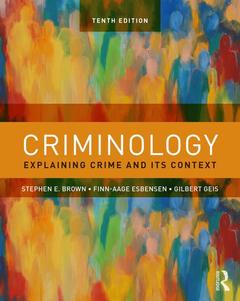Criminology (10th Ed.) Explaining Crime and Its Context
Auteurs : Brown Stephen E., Esbensen Finn-Aage, Geis Gilbert

How do societies define crime, and how should it be punished or prevented? Which is a more criminal act, causing a death by dumping toxic material or by shooting a victim with a gun? Are criminals born or made? Criminology: Explaining Crime and Its Context, Tenth Edition, offers a broad perspective on criminological theory. It provides students of criminology and sociology with a thorough exposure to a range of theories about crime, contrasting their logic and assumptions, but also highlighting efforts to integrate and blend these frameworks. In this tenth edition, the authors have incorporated new directions that have gained traction in the field, while remaining faithful to their criminological heritage. Among the themes in this work are the relativity of crime (its changing definition) with abundant examples, historical roots of criminology and the lessons they have provided, and the strength and challenges of applying the scientific method. This revision offers new coverage of the growing problem of mental health and crime, a more tightly focused discussion of crime statistics, more global examples, and new material on human trafficking and on youth violence. Brown and Esbensen improve on this engaging and challenging introduction to the theory of crime and punishment, which is already perhaps the best criminology text available for undergraduates today.
Part I: Foundations for Criminology 1. Crime and Criminology 2. The Relativity of Law and Crime 3. Crime Statistics and the Distribution of Crime Part II: Theories of Crime 4. Deterrence and Rational Choice Theories of Crime 5. Positivism and BioPsychoSocial Criminology 6. Social Structure Theories of Crime 7. Social Process Theories of Crime 8. Social Reaction Theories of Crime 9. New Directions: Integration and a Life-Course Perspective Part III: Types of Crime 10. Violence 11. Economic Crime 12. Crimes without Victims and Victims without Crimes 13. Youth Violence
Stephen E. Brown is Professor of Criminology and Criminal Justice at Western Carolina University where he served as Department Head for over ten years. He received his Ph.D. in Criminal Justice and Criminology from the University of Maryland in 1979. He went through the professorial ranks at East Tennessee State University, serving as Department Chair for 11 years, and left as Professor Emeritus in 2008. Brown has published articles in a number of journals, including Criminology, Journal of Criminal Justice, Journal of Criminal Justice Education, Criminal Justice Review, Youth and Society, and Social Science Quarterly. His areas of research interest have been broad, covering topics such as family violence, deterrence, delinquency, and application of statistics within criminology. He has served as a Trustee on the board of the Academy of Criminal Justice Sciences, and as editor of the American Society of Criminology’s The Criminologist. He co-edited the Routledge Handbook on Deviance in 2018.
Finn-Aage Esbensen is E. Desmond Lee Professor of Youth Crime and Violence in the Department of Criminology and Criminal Justice at the University of Missouri, St. Louis. He served as Department Chair from 2009 to 2018. His previous faculty positions were at Western Carolina University (1982–1986) and the University of Nebraska at Omaha (1992–2001). In addition to these academic appointments, he has held research positions at the following institutions: the Center for Criminal Justice at Harvard Law School (1974); Catholic University (1976–1977); the Behavioral Research Institute, Boulder, Colorado (1980–1981); and the Institute of Behavioral Science, University of Colorado (1987–1992). He received his B.A. and M.A. from Tufts University and his Ph.D. from the University of Colorado. He is the author of more than 100 articles and chapters examining, among other topics, youth gangs and violence, methodological issues,
Date de parution : 01-2019
18.7x23.5 cm
Date de parution : 12-2018
19.1x23.5 cm
Thèmes de Criminology :
Mots-clés :
Young Men; Capital Punishment; Criminology; Antisocial Behavior; Crack Cocaine; Crime; NCVS Data; Crime statistics; UCR Data; Sociology; White Collar Crime; Social structure; White Collar Offenders; Street Code; Critical Criminology; Bullying Victimization; Social reaction; Low Self-control; Social process; High Aid Death Rate; Rational choice; Criminal Career Paradigm; Adolescence Limited Offenders; Differential Association; Social Process Theories; Criminological theory; NCVS; Illegitimate Opportunity Structures; Age Graded Theory; Social Disorganization Theory; Gang Members; Labeling Perspective; Culture Conflict Theories; Biosocial Criminology



